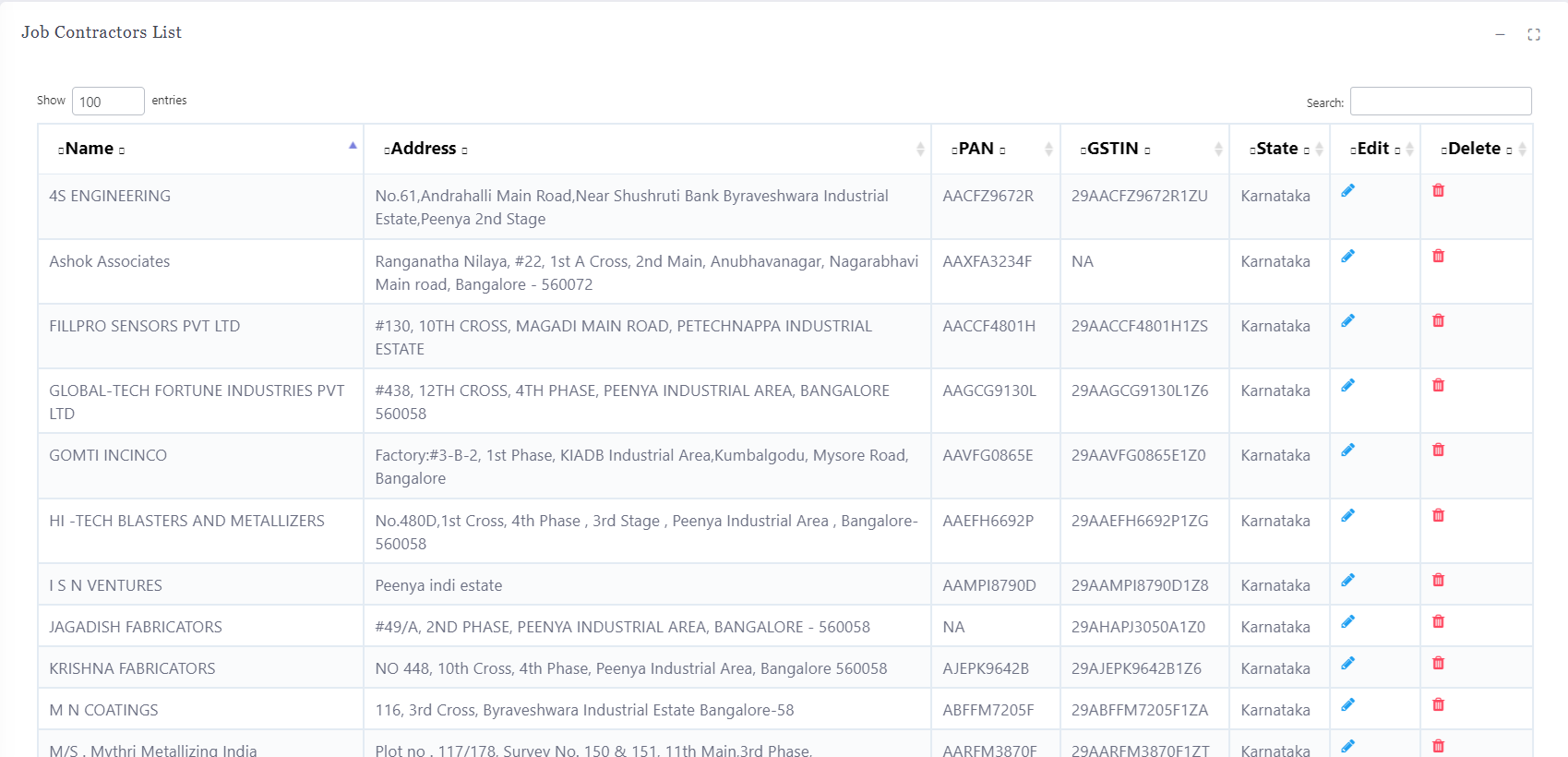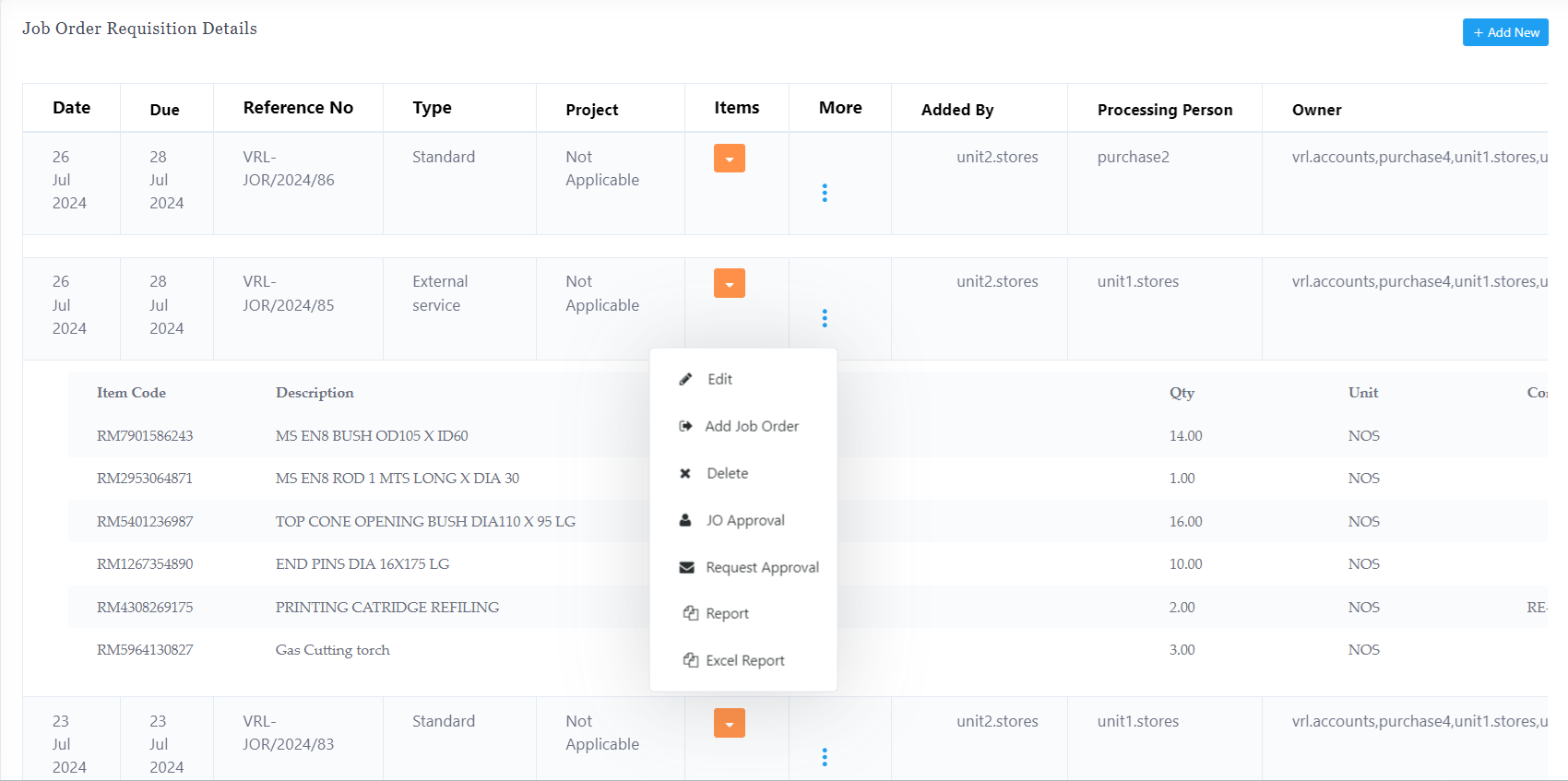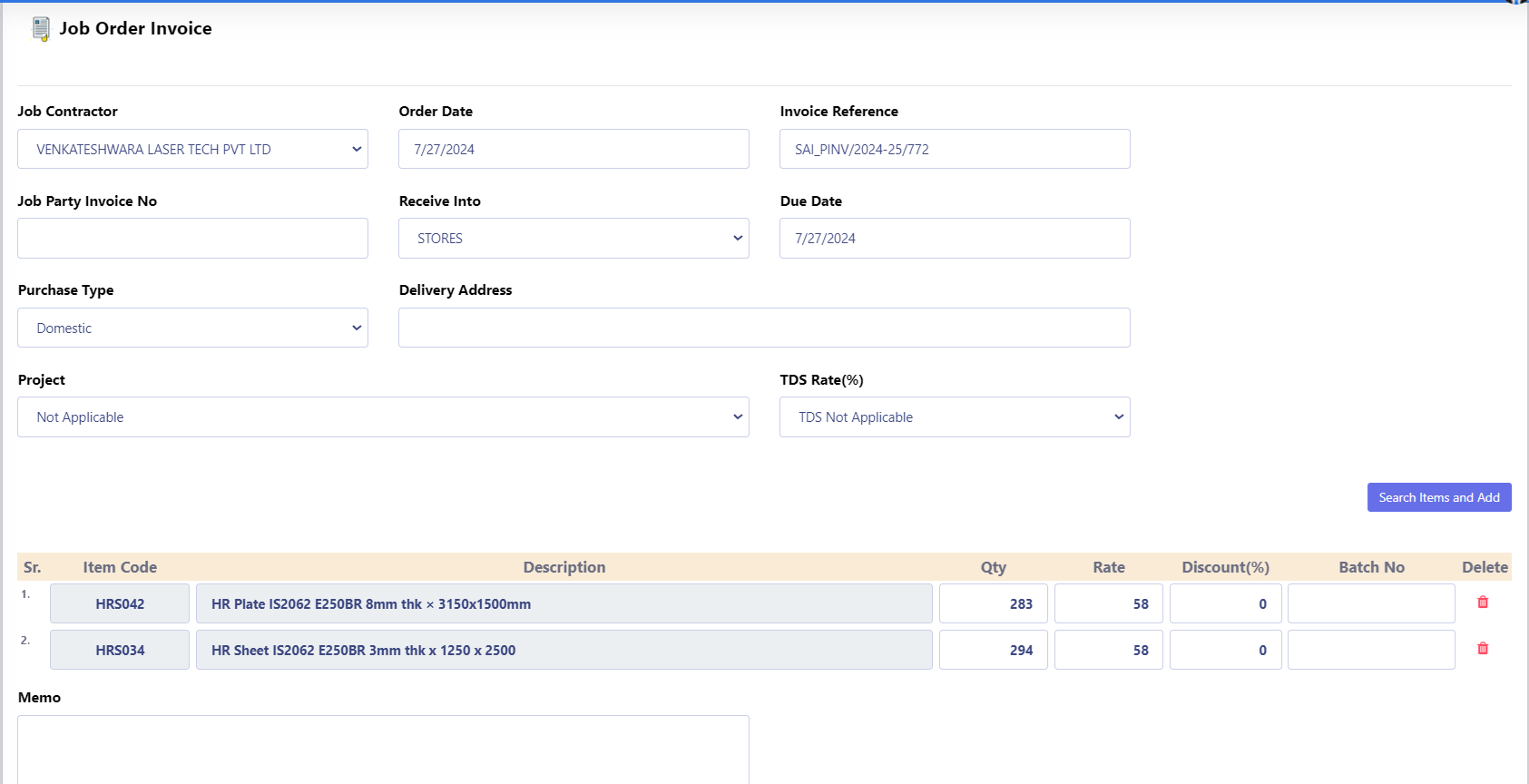Job Order
Context
In Peacksoft ERP, Job Orders provide a streamlined way to manage production activities that require external third-party assistance when certain tasks or processes cannot be handled in-house. The system handles everything from the initial evaluation of third-party vendors to the actual transfer of goods, ensuring full transparency and control over outsourced production. Here’s a breakdown of the main components and processes involved:
1. Job Order Party Management:
Third-Party Setup: Any external vendor or service provider is managed in the system similarly to a supplier. They are assigned a creditor ledger code for accounting purposes, allowing the company to track job order service charges as an expense.
Evaluation and Selection: The system facilitates the evaluation of potential outsourcing partners based on their past performance, service rates, and compliance with company standards.
2. Job Order Requisition:
Department Requests: Different departments within the company can raise a requisition to the store department, specifying the items to be processed and the type of operation involved.
Request Flow: This internal request for outsourcing helps ensure that the necessary processing steps are completed in a timely manner, and the required goods are delivered to the third-party vendor.
3. Job Order for Finished or Semi-Finished Goods:
Finished Goods Outsourcing (Out Type): The company can outsource a job order to a third party for converting raw materials into finished goods. The raw materials are sent to the external vendor, who processes and returns them as a finished product.
Semi-Finished Goods Outsourcing: In certain cases, the company can send semi-finished goods to the vendor for further processing to produce another semi-finished good, which can be part of a larger production process.
Job Order In Type: The company can also receive job orders from other businesses, effectively acting as an outsourcing provider for another company. In this case, the receiving company processes raw or semi-finished goods supplied by the client.
4. Job Order RFQ, Quotation, and Purchase Order (PO):
Request for Quotation (RFQ): Before finalizing a job order, the company can send RFQs to multiple third-party vendors. This request helps in gathering quotes and assessing the service offerings from different providers.
Quotation Management: Once quotes are received, the company can perform a comparative evaluation of the bids to choose the most suitable provider based on criteria such as cost, turnaround time, and quality of work.
Purchase Order (PO): After selecting a vendor, a job order PO is generated in the system with details like:
Terms and conditions for processing the materials.
Job Order processing charges per unit of material.
Delivery schedules, quality standards, and payment terms are also outlined in the PO to ensure clear communication and accountability.
5. Goods Transfer and Return:
Goods Out: The system facilitates the transfer of raw or semi-finished goods to the third-party vendor for processing. Proper documentation is created to track the outbound movement of goods.
Goods In: Once the processing is complete, the modified or finished goods are returned to the company. This process is tracked and recorded in the ERP to maintain accurate inventory levels and ensure proper reconciliation of materials.
Benefits of Job Order Management in Peacksoft ERP:
Cost Control: By managing outsourcing services through RFQs, quotations, and POs, companies can ensure competitive pricing and cost-effective solutions.
Seamless Tracking: Every stage, from requisition to goods transfer and return, is tracked within the system, ensuring visibility and traceability.
Comprehensive Reporting: The system provides detailed reports on all job orders, allowing for better decision-making regarding external production activities.
Vendor Performance Evaluation: Continuous tracking and evaluation of vendor performance based on quality, delivery time, and cost ensure better management of third-party relationships.
This feature-rich process helps streamline external production activities while maintaining full control over the costs and quality of outsourced operations.








Goods Out
Job Order Goods Out in Peacksoft ERP plays a critical role in managing and tracking the raw materials or semi-finished goods sent to Job Order (JO) contractors. This function ensures that inventory levels are accurately adjusted, and shipping details are captured as goods are transferred to external parties for processing. Here’s a detailed overview of how it works:
Recording Raw Material Transfer:
Raw Materials for Finished Goods: When raw materials are sent to a JO contractor to produce finished goods, the system logs the details of each item, including the quantity, material specifications, and expected output.
Semi-Finished Goods Transfer: In cases where semi-finished goods are sent for further processing, the transfer is similarly recorded, ensuring that the specific stage in the production process is documented.
Shipping and Delivery Details:
Shipping Information: The goods out process includes details of the shipping method, transporter information, shipment date, and expected delivery time at the JO contractor's location.
Item Specifications and Quantities: Each item transferred to the contractor is accompanied by its specifications (e.g., item code, description, weight, batch numbers if applicable) and the corresponding quantity. This ensures clear communication between the company and the contractor.
Packing List and Documentation: The system generates relevant shipping documents, including packing lists and delivery challans, to facilitate the smooth transfer of goods.
Inventory Updates:
Inventory Adjustment: Once the goods are dispatched to the JO contractor, the system automatically updates the inventory levels in the company's location. The stock of raw materials or semi-finished goods is reduced accordingly to reflect the physical transfer.
Job Order Location Tracking: The system maintains a record of the materials transferred to external locations, associating them with the specific Job Order. This allows users to track the whereabouts of company-owned goods until they are returned as finished or processed items.
Batch and Serial Numbers: If the materials involve batch or serial numbers, the system tracks these details to maintain full traceability throughout the production process.
Goods in Transit Tracking:
Goods Out Status: The system allows tracking of goods that are in transit to the contractor, ensuring that the company is aware of which items have been dispatched but not yet received by the third-party vendor.
Expected Return of Goods: The ERP records the expected return date or timeframe for when the finished or processed goods should be received back at the company’s warehouse.
Goods In
It records the finished good or semi finished good sent back to the company from JO contractors. It also mentions shipping details with item specifications and qty. it updates the inventory of the goods transferred w.r.t company location.



Job Order Process BOM
In Peacksoft ERP, the Goods In vs. Goods Out relationship is crucial for managing the flow of materials to and from Job Order (JO) contractors. It helps users track the return of processed items after outsourcing and ensures accurate documentation of how materials are transformed. By setting up this relationship, the process of adding Goods In records based on prior Goods Out records becomes streamlined, improving efficiency when receiving multiple types of items in varying quantities.
Mapping Goods In and Goods Out:
Goods Out (Materials Sent): The system keeps a record of the raw materials or semi-finished goods sent out to the JO contractor for processing. This forms the base for the Goods In record when the finished or further-processed items are received back.
Goods In (Materials Received): Once the job order is completed, the company receives the finished or semi-finished goods from the contractor. The system allows users to automatically map this Goods In record to the original Goods Out transaction, ensuring the materials are accounted for in the correct quantities and item types.
Automating Goods In Entry:
Automated Linkage: By pre-defining the expected output for each Goods Out record, the system can automate the creation of Goods In records once the processing is completed. This is especially useful for situations where multiple types of goods are received from a single Goods Out transaction.
Handling Multiple Item Types: The system supports the scenario where, from one Goods Out (such as raw materials), several types of Goods In (finished goods or semi-finished items) are returned, each with different quantities. The user can pre-set these expected outputs, which simplifies the Goods In process.
Examples of Goods Transformation:
Single Goods Out, Multiple Goods In: For example, if the company sends out steel and plastic materials to a contractor, they might receive multiple finished products like metal frames and plastic components, each with varying quantities. The system allows users to set up these relations so that when the job order is completed, Goods In records are automatically populated based on the specific materials sent out.
Conversion Efficiency: For batch processing, the system will recognize how the raw material (Goods Out) is divided into finished products (Goods In) with defined conversion rates and will adjust inventory accordingly.


Goods Summary and JO Invoice
The JO Goods Summary Report in Peacksoft ERP plays a crucial role in ensuring the reconciliation between Goods Out (materials sent to the job order contractor) and Goods In (finished or semi-finished goods received after processing). It provides a clear and detailed overview of the quantities for each item involved in the job order process, allowing for better inventory tracking and financial accuracy.
Reconciliation of Goods Out and Goods In:
Comparison of Sent and Received Quantities: The report compares the quantities of materials sent to the job order contractor (Goods Out) with the quantities received (Goods In) after processing. It highlights any discrepancies or differences in the quantities, ensuring that all materials are accounted for.
Quantity Balance for Each Item: For every item involved in the job order, the report shows the balance, indicating whether all materials have been returned or if any materials are still outstanding.
Tracking Multiple Types of Goods:
Handling of Multiple Items: The report can handle scenarios where multiple types of finished or semi-finished goods are received from a single Goods Out transaction, displaying the balance for each item type.
Real-Time Status: As Goods In records are updated, the report provides a real-time view of the status of each item, ensuring that the user has the most up-to-date information on material movement.
Discrepancy Identification:
Highlighting Variations: If there are discrepancies between the quantities sent and received, the system flags these differences, helping the company address any issues with the job order contractor. This ensures that no materials are lost or unaccounted for during the outsourcing process.
Job Order Invoice (Contract Invoice):
Once the job order is completed and the Goods In has been processed, the company can generate a Job Order Invoice for the service provided by the contractor. This invoice reflects the charges associated with processing the job order and is recorded as an expense for the company.
Invoice Creation from Job Order Record:
Post-Goods In Process: The system allows users to create a Job Order Invoice from the corresponding job order record once the Goods In process has been completed. This ensures that the invoice is tied to the actual materials received and the job order completed.
Inclusion of Processing Charges: The invoice includes the job order processing charges as agreed in the job order contract (per unit or batch), ensuring accurate billing for the services provided by the contractor.
Get Started with Peacksoft ERP Today
Intuitive solutions on cloud with integrated features like Accounting, Purchase, Sales, Production, CRM, Payroll, Inventory & Filing of all compliances. . Call us at +91-86608 58802 (M: 9845167247) to schedule a consultation.



 Manage sales through quotation by updating information and proceed to Sales order, Sales delivery , Sales invoice by click of few button.
Manage sales through quotation by updating information and proceed to Sales order, Sales delivery , Sales invoice by click of few button.
 Manage Purchases through order by updating information and proceed to GRN, Purchase Invoice by click of few buttons.
Manage Purchases through order by updating information and proceed to GRN, Purchase Invoice by click of few buttons.
 Comprehensive Inventory management features for small and mid size companies.
Comprehensive Inventory management features for small and mid size companies.
 Manufacturing
Manufacturing